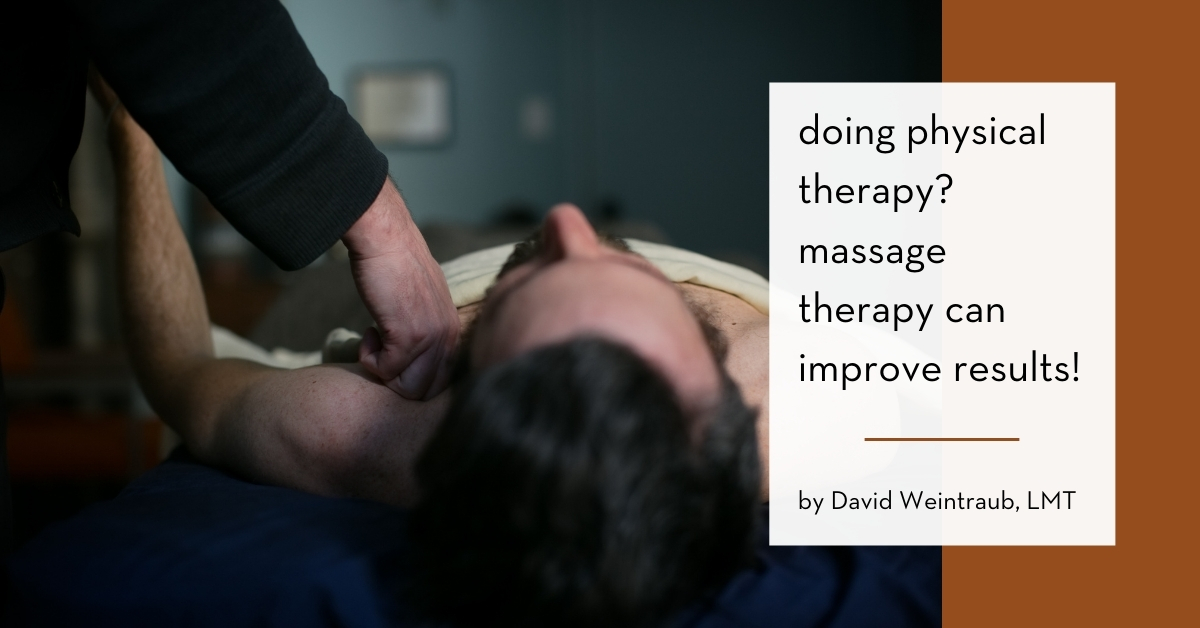Doing Physical Therapy? Massage Therapy Can Vastly Improve Results!
David Weintraub, LMT and owner of Bodyworks DW, writes about the benefits of supplementing your physical therapy plan with massage therapy treatment. Physical therapy and massage together can produce profound synergistic results above and beyond what each can provide separately.
7 Reasons why this powerful combination works
Pain sucks. As a massage therapist, I would know. Almost everyone who comes to see me does so because they're in pain! Many times, they are already seeing a physical therapist and not entirely happy with the results. What many don't realize is that the combination of physical therapy and massage can give greater results than either modality on it's own.
Physical therapy and massage therapy are both powerful methods for treating pain - When used together, they can help clients achieve faster and better results!
There are several reasons why massage therapy is effective for anyone who is already receiving physical therapy.
Here are the top 7:
- Providing more immediate pain relief, often times after the first session
- Increasing range of motion so that the body can move better, which makes PT exercises easier to do
- Decreasing local inflammation by working above and below the area
- Lessening the pain clients may be feeling during or after physical therapy exercises
- Decreasing the pain clients may feel post-surgery
- Bringing faster results than just physical therapy alone
- Motivating clients to stick to their physical therapy treatment plan
That's the short version of why massage therapy and physical therapy are a powerful combination. If you're interested in a more detailed explanation, read below!

Most of the time, my clients have such a powerful response to massage therapy they don't need additional therapies. However, that isn't always the case. I always look for clues that indicate I may need to refer a client to another practitioner, such as a physical therapist.
Update September 2020: Sometimes those clues are less about what the "best" course of treatment would be. And more about finding a way to help a client make their budget work. PT is covered by insurance far more often than massage therapy is (for now). Sometimes, I think a combination of PT and massage will work as well as massage on it's own. If so, I will often recommend a client work with a PT 1-2 times a week and with me once every 2-4 weeks.
The PT will help the client make small but steady gains. In my sessions, I'll then focus on making bigger leaps. Assuming the PT sessions are covered by insurance, the client spends less money overall and arrives at a pain free place. It just might take a little bit longer to get there. You can find several great PT's that we send clients to on our colleagues page!
The Breakdown:
1) Massage therapy helps by treating short and overused muscles.
The goal of many physical therapy exercises is to help strengthen any weak muscles that are causing pain symptoms. The goal is that by strengthening weak muscles, the body will move & feel healthier. But that's only half the picture.
When it comes to muscles, imbalance happens when one muscle is weak and long while another muscle is overused, chronically tight, and short. In order to correct the imbalance faster, BOTH of these problems need to be addressed. This means following the exercises provided by a physical therapist teaching clients how to engage and strengthen muscles that are weak. It also means using massage therapy to address the muscles that are chronically overused and tight.
The right massage therapist in NYC will focus on releasing these tight muscles as well as lengthening them when they've gotten short. This can help effectively decrease pain while also improving range of motion and helping the nervous system learn how to move better!
2) Massage therapy will help make physical therapy more effective and easier to do.
Studies show that one major obstacle to physical therapy treatment is that many will stop coming in if the exercises are painful to do, or if their pain doesn't decrease right away. (Source: Read this article) (1) Basically, if the work is too hard and painful, people are a lot less likely to do it. Massage therapy can decrease pain, often with immediate results. Which will help provide motivation to stick to the physical therapist's treatment plan.
3) Massage therapy can help post-surgical recovery.
Sometimes people will experience new aches and pains after their recovery from a surgery, even while doing physical therapy. This can happen due to a change in the body alignment and how the body moves after the procedure. If clients are already doing regular physical therapy and still experiencing pain post-surgery, I suggest asking a doctor if it’s medically safe to try massage therapy as well.
For more detailed information on massage therapy after surgery, please check out this in-depth article: Click Here! (2)
In summary, we see that combining physical therapy and massage therapy help clients move better and feel better by working on correcting any muscular imbalances that can be causing or contributing to pain.
Want to book a massage at Bodyworks DW?
Book AppointmentFurther Reading
- Tag Team for Your Shoulder Pain: Massage Therapy and Physical Therapy
- Medical Massage in New York at Bodyworks DW
- What does a Massage Therapist do?
- Does Massage Therapy Really Work? What New Medical Studies Are Saying
- You really can't ask for better results!(testimonial)
Citations
-
NCBI from National Institute of Health: Barriers to treatment adherence in physiotherapy outpatient clinics: A systematic review
- American Massage Therapy Association: Helping Patients After Surgery



Pingback: Doing Physical Therapy? Massage Therapy Can Improve Results! – Bodyworks DW
Pingback: Harmony in Healing: The Synergy of Massage Therapy and Physical Therapy - Midland Sports Rehab